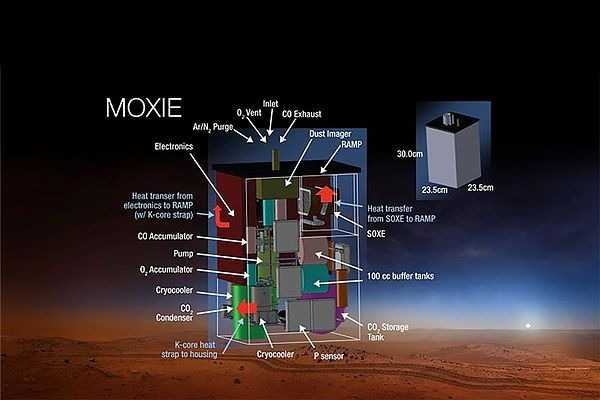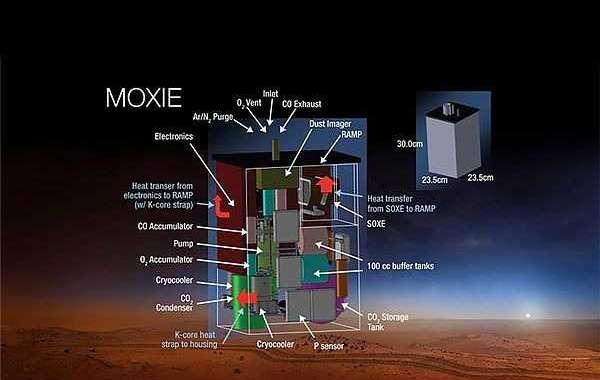click here to join the blue and red idea network's social media network
But on this dusty, dry, alien world, a small instrument, little bigger than a briefcase, produces breathable oxygen from the Martian atmosphere.
This is the first demonstration of processing ground resources for human use on another planet – creating a way in which breathable air could be produced for a human mission to the red planet.
It's called MOXIE (Mars Oxygen In-Situ Resource Utilization (ISRU) Experiment) and, installed in the belly of NASA's Perseverance rover, it uses a process called electrolysis to break down Martian carbon dioxide into carbon monoxide and oxygen.
From February 2021, when Perseverance landed, to the end of 2021, MOXIE has produced oxygen seven times – and will continue to do so, the researchers said.
"This is the first demonstration of actually using resources on the surface of another planet and chemically converting them into something that would be useful for a human mission," says former NASA astronaut and MOXIE deputy principal investigator Jeffrey Hoffman of MIT.
"It is a historic moment from this point of view".
The production of oxygen through electrolysis is nothing new. The International Space Station, for example, uses electrolysis to split water into hydrogen and oxygen to supplement its supply of breathable air.
moxie oxygen generator 598x415
However, on Mars, water may be too precious to be used in this way.
Fortunately, oxygen is a component of many compounds, including the carbon dioxide that makes up about 96% of the atmosphere on Mars: a molecule made up of one carbon atom and two oxygen atoms.
The electrochemical reduction of carbon dioxide to its constituent elements is well studied, known and understood - the challenge was to develop, here on Earth, an instrument that could do it on Mars with the materials available.
Oxygen production on Mars step by step
The production of oxygen by MOXIE is a multi-step process.
First, it draws Martian air through a filter that cleans it. This purified Martian air is compressed, heated and sent to the solid oxide electrolyte (SOXE). The electrolyte breaks down the carbon dioxide into carbon monoxide, which is released back into the Martian atmosphere, and into oxygen ions.
The oxygen ions are then recombined into O2 or molecular oxygen, which is measured for quantity and purity before being released back out.
This process, as the scientists found, reliably led to the production of breathable oxygen. After several hours of warm-up, run for 1 hour per experiment, followed by a shutdown period.
In this 1 hour of operation, MOXIE is designed to produce up to 10 grams – about 20 minutes of breathable oxygen for an astronaut.
In each of its seven tests, MOXIE produced between 5.4 and 8.9 grams of molecular oxygen, for a total of 49.9 grams.
MOXIE O2 generator

Since the temperature and air density on Mars vary greatly, not only from day to night, but also during the changing seasons of the year, MOXIE must be able to operate over a wide range of temperatures and air densities.
In its seven tests, MOXIE was able to produce oxygen in various conditions: during the day, at night, and throughout the year.
"The only thing we haven't demonstrated is operation at dawn or dusk, when the temperature changes significantly," says MOXIE principal investigator Michael Hecht of MIT's Haystack Observatory.
"We have an ace up our sleeve that will allow us to do this, and once we test it in the lab, we can reach this final milestone to show that we can actually run at any time."
Ideally, of course, the goal is a life support system that can work continuously, since that's how people should breathe. And it would have to be much bigger than MOXIE: a small team of astronauts, Hecht said last year, would need about a metric ton of breathable oxygen for a single year on Mars.
And that's not including the oxygen needed for the propellant for the return trip — in total the mission would need about 500 tons of oxygen, the team estimated.
The next experimental test will take place at the time of year when the atmosphere is denser. Then, the team said, they will push the instrument to its limits, to try to produce as much oxygen as they can.
This will not only show what MOXIE can do, but also demonstrate its limitations, which, in turn,this will help build a more powerful engine for the eventual manned mission to Mars.
And that will solve an important part of the puzzle of not only making Mars a habitable place more welcoming to humans, but also ensuring their safe return home.
click here to join the blue and red idea network's social media network









